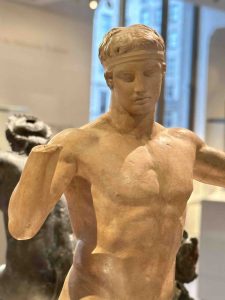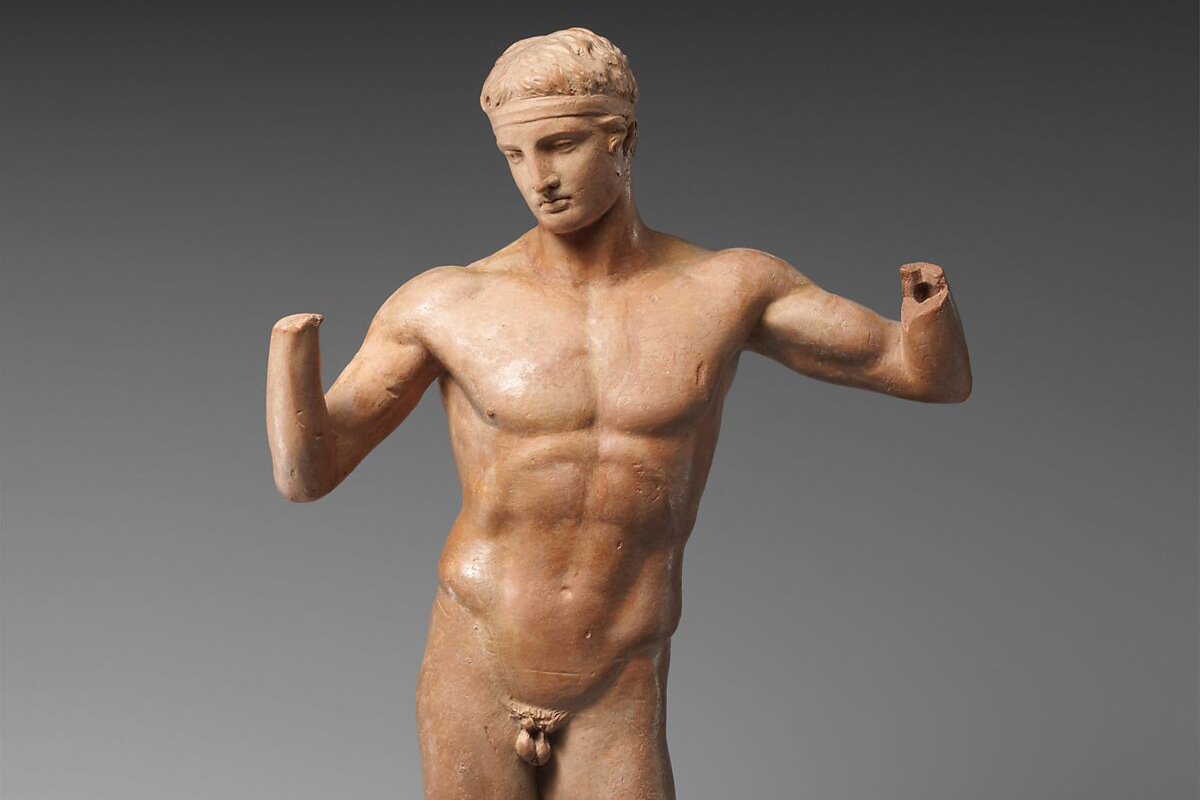
Original Location:
- Greece, said to be from Smyrna
- 1st century B.C.
Permanent Location:
- Metropolitan Museum of Arts, New York
- Gallery 164
The Medium:
- Terracotta
The Subject:
This is a copy of a Greek bronze statue of ca. 440—430 B.C. by Polykleitos also spelled Polyclitus. No information on the artist who made the terracotta copy. Therefore, let’s talk about the original sculptor.
Polykleitos was an ancient Greek sculptor from the school of Argos of the 5th century B.C.
He mastered bronze sculptures of young athletes and was well known for this figural type called Diadumenus or “Diadem Bearer”. Another type he was famous for is the “Spear Bearer” known as The Canon. Both fruits of Ancient Greece's “high classical“ period.
The “Diadem Bearer” also spelled Diadumenos, or youth tying the ribbon-band of the winner around his head is the winner of an athletic contest. The bronze original of about 420 B.C. would have been represented by a ribbon of the same material. In Hellenistic times the diadem became a symbol of royalty.
Alongside the Athenian sculptors Phidias, Myron and Praxiteles, Polykleitos was considered one of the most important sculptors of classical antiquity.
Phidias was credited with a statue of a victor at Olympia in the act of tying the fillet around his head. Polykleitos' successors Lysippos and Scopas also created figures of this kind.
The Canon
During the classical period, art was considered to be the finest of the finest. Copying classical masters like Polykleitos was important for an artist. Polykleitos created a new approach to sculpture with its Kanṓn. This “measuring rod, standard”, canon of ideal male proportions was very intellectual. Its purpose was to honor the gods, who were in the same image of humans.
This approach set in motion the perfect proportions of the body up to the phalanges of a human hand. The main principle of the canon was expressed by the Greek words symmetria, isonomia (“equilibrium”), and rhythmos. This standard was later emulated by future generations.
According to Stoic philosopher Chrysippus (c. 280—207 B.C.) health in the body was the result of the harmony of its constituent elements.

Additionally, Alkmaion of Kroton (c. 500—450 B.C.) writes about health of the body:
What preserves health is the equality (isonomia) of the powers -wet, dry, hot, cold, sweet, and so forth —whereas the domination (monarchia) of any one of them engenders disease; for the rule of a single contrary is destructive. The active cause of disease is excess of heat or cold, the occasion of it excess or insufficiency of nourishment, the seat of it blood, marrow, or the brain. Disease may also be engendered by external causes such as water, environment, exhaustion, torture, or the like. Health on the other hand is a proportionate (symmetron) mixture of opposites.
Source: article linked under "more reading"

This particular terracotta copy depicts slender and graceful forms conforming to Late Hellenistic taste. They are other copies you can see in other museums such as the reconstruction, in a patinated cast at the Pushkin Museum, Moscow.
The source of the following excerpt is originally from the Louvre's website. The page is now down:
“Polykleitos was fascinated by the male form and its reproduction according a system of skillful calculations that he set out in his treatise, the Canon. The Diadumenus was the fruit of this intellectual approach, which was of seminal importance in the history of Greek sculpture.“ Louvre website

No Comments.